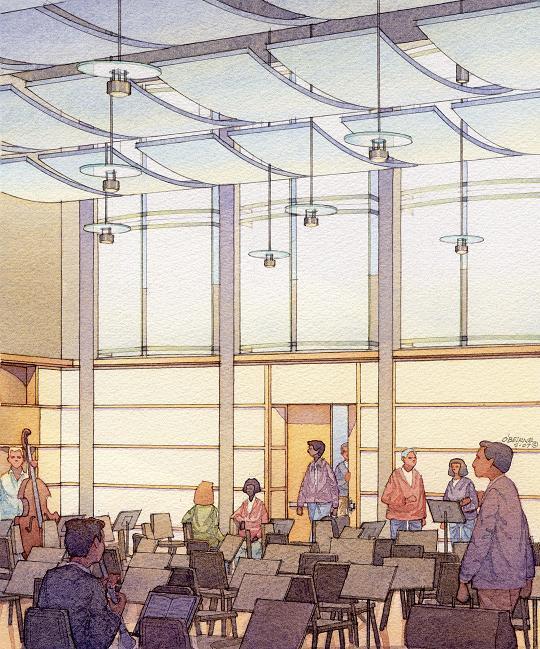
With a new location for all its music education programming, the Rhode Island Philharmonic is hoping to triple the enrollment at its Music School and become a more active advocate for music education in public and private schools in the state. But there is much work to be done.
Last week, the Philharmonic announced a $12 million capital campaign for its orchestra and school, with $7 million earmarked for renovations to the school’s new home, at 667 Waterman Ave. in East Providence, and the remainder for the Philharmonic’s endowment.
The campaign was inspired by a $2 million challenge grant from John and Letitia Carter’s Carter Family Charitable Trust, said Marie Langlois, capital campaign co-chair.
The Carters stipulated in giving the grant that the Music School must raise matching funds within a year. But the nonprofit is taking its fundraising efforts one step further.
“You make us think big,” Langlois told the Carters at the event. “You make us raise our sights.”
After matching the grant, she said, the Philharmonic plans to raise an additional $3 million for the school renovations and another $5 million for its endowment, which would bring the total endowment to just over $7 million.
At that level, the endowment would provide a “stable financial foundation to offer programs,” said David Beauchesne, director of education and community partnerships.
The Philharmonic bought the 50,000-square-foot building – the former home of the Meeting Street school – in December for $3 million. But it expects renovations to cost more than the building itself, said executive director David Wax, who expects the project to be completed by the end of the year.
Wax said the Philharmonic had been looking for a central location for itsMusic School since the orchestra and school merged seven years ago. “What we needed was a building well-located, that was easily accessible, had parking available and was of a certain size,” he said.
The Music School now operates in three locations: at Nathanael Greene Middle School in Providence, St. John’s Episcopal Church in Barrington and St. Luke’s Church Parish School in East Greenwich.
Yet despite the school’s decentralized nature – and classrooms that Wax describes as inappropriate studios without the proper acoustics – enrollment has grown from 1,054 students in 2000 to 1,641 last year. “Clearly there’s demand,” Wax said, noting that there is a growing need for music education in the state and surrounding areas.
“Right now music education comprises slightly more than half of our total business,” he said. “We see this as much more of a growth area.”
Tuition from students and grants the nonprofit receives for music education generate about 40 percent of its total operating budget. The rest comes from orchestra fees for service and ticket sales (30 percent), individual giving (13 percent) and income from the endowment and fund-raising events.
“We … devote the largest percentage of total activity to education and community work,” Wax said. “That’s only going to increase as we open this center.”
In addition, the new music center will allow the nonprofit to add more daytime programs targeting preschoolers, adults and seniors. The daytime offerings could help double or triple enrollment, since the center’s capacity is three times what the school currently handles.
And having a central location will help the school become a stronger advocate and model for in-school music education programs, Beauchesne said.
Advocacy is becoming more necessary as music education in schools declines, because it spurs students’ interest in taking outside lessons, he said. Without being exposed to music education in school, students might not be inspired to take individual lessons or join an ensemble.
“We have to support music in public and private schools,” Beauchesne said. “We have to work collaboratively with them.”












